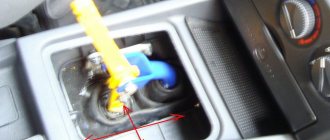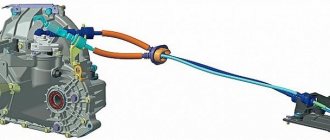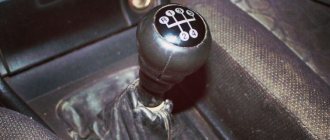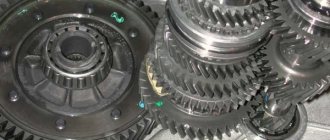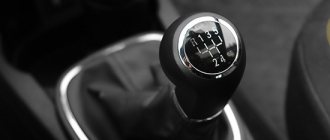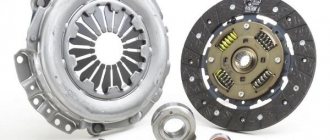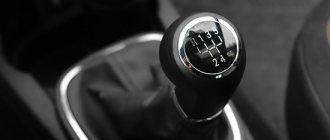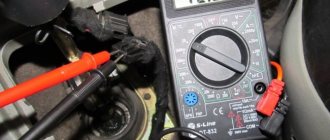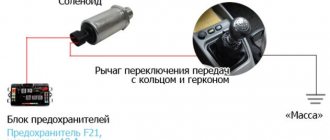Sports rows of the VAZ checkpoint
On VAZ 2108-10 cars, as well as Lada Kalina and Priora, you can notice that the first gear is too short. In addition, there is a large gap between first and second gears, and there is not enough traction in fifth gear. Refining or tuning the gearbox (for example, installing a sports series and a different main pair/gear) allows you to get rid of these shortcomings. The table shows the vehicle speed at 5000 rpm (wheels 185/60R14).
| Main couple (GP) | 1st gear3.64 40/11 | 2nd gear1.95 39/20 | 3rd gear1.35 38/28 | 4th gear0.94 32/34 | 5th gear0.78 29/37 | 6th gear0.69 27/39 | Standard, serial gearbox |
| 3,7 | 40 | 74 | 106 | 154 | 184 | 209 | |
| 3,9 | 38 | 70 | 101 | 145 | 174 | 198 | |
| 4,1 | 36 | 67 | 96 | 139 | 166 | 188 | |
| 4,3 | 34 | 64 | 92 | 132 | 159 | 180 | |
| 5 row | 2,92 38/13 | 1,81 38/21 | 1,27 37/29 | 0,96 32/33 | 0,78 29/37 | 0,69 27/39 | Sports |
| 3,7 | 50 | 80 | 114 | 149 | 184 | 209 | For a boosted engine |
| 3,9 | 47 | 76 | 108 | 141 | 174 | 198 | |
| 4,1 | 45 | 72 | 102 | 134 | 166 | 188 | Popular |
| 4,3 | 43 | 69 | 98 | 128 | 159 | 180 | |
| 6 row | 2,92 38/13 | 1,81 38/21 | 1,27 37/29 | 1,06 34/32 | 0,94 32/34 | 0,78 29/37 | Sports |
| 3,7 | 50 | 80 | 114 | 136 | 154 | 184 | |
| 3,9 | 47 | 76 | 108 | 129 | 145 | 174 | |
| 4,1 | 45 | 72 | 102 | 122 | 139 | 166 | Popular when installing 6th gear, dynamics + long gears |
| 4,3 | 43 | 69 | 98 | 117 | 132 | 159 | |
| 7 row | 2,92 38/13 | 2,05 39/19 | 1,56 28/18 | 1,31 28/29 | 1,13 35/31 | 0,94 32/34 | Rally, motocross |
| 3,7 | 50 | 70 | 93 | 110 | 128 | 154 | |
| 3,9 | 47 | 67 | 88 | 105 | 121 | 145 | |
| 4,1 | 45 | 63 | 84 | 100 | 116 | 139 | For drag racing, tuned naturally aspirated engine, dynamics + long gears |
| 4,3 | 43 | 61 | 80 | 95 | 110 | 132 | |
| 8 row | 3,42 41/12 | 2,11 40/19 | 1,35 38/28 | 0,96 32/33 | 0,78 29/37 | 0,69 27/39 | Commercial |
| 3,7 | 42 | 69 | 106 | 149 | 184 | 209 | |
| 3,9 | 40 | 65 | 101 | 141 | 174 | 198 | |
| 4,1 | 38 | 62 | 96 | 134 | 166 | 188 | Popular, dynamics + long gears |
| 4,3 | 36 | 59 | 92 | 128 | 159 | 180 | Dynamics + long passes |
| 11 row | 3,64 40/11 | 2,22 40/18 | 1,54 40/26 | 1,17 35/30 | 0,87 31/35 | 0,78 29/37 | Popular when installing 6th gear |
| 3,7 | 40 | 65 | 94 | 124 | 163 | 184 | For everyday use with a forced engine |
| 3,9 | 38 | 62 | 89 | 117 | 155 | 174 | |
| 4,1 | 36 | 59 | 85 | 112 | 147 | 166 | For motorsport |
| 4,3 | 34 | 56 | 81 | 107 | 140 | 159 | |
| 12 row | 3,17 38/12 | 1,95 39/20 | 1,35 38/28 | 1,03 33/32 | 0,78 29/37 | 0,69 27/39 | Repairable |
| 3,7 | 46 | 74 | 106 | 140 | 184 | 209 | |
| 3,9 | 43 | 70 | 101 | 133 | 174 | 198 | For a boosted engine |
| 4,1 | 41 | 67 | 96 | 126 | 166 | 188 | |
| 4,3 | 39 | 64 | 92 | 119 | 159 | 180 | |
| 18 row | 3,17 38/12 | 2,11 40/19 | 1,48 40/27 | 1,13 35/31 | 0,87 31/35 | 0,78 29/37 | Popular |
| 3,7 | 46 | 69 | 98 | 128 | 163 | 184 | City-highway, for a forced engine |
| 3,9 | 43 | 65 | 92 | 121 | 155 | 174 | |
| 4,1 | 41 | 62 | 88 | 116 | 147 | 166 | For the city |
| 4,3 | 39 | 59 | 84 | 110 | 140 | 159 | |
| 200 row | 2,92 38/13 | 2,22 40/18 | 1,76 37/21 | 1,39 39/28 | 1,17 35/30 | 0,94 32/34 | |
| 3,7 | 50 | 65 | 82 | 104 | 124 | 154 | |
| 3,9 | 47 | 62 | 78 | 99 | 117 | 145 | |
| 4,1 | 45 | 59 | 73 | 93 | 112 | 139 | |
| 4,3 | 43 | 56 | 71 | 89 | 107 | 132 | |
| 102 row | 3,17 38/12 | 1,95 39/20 | 1,35 38/28 | 0,94 32/34 | 0,73 | For boosted engines | |
| 3,7 | 46 | 74 | 106 | 154 | 196 | ||
| 3,9 | 43 | 70 | 101 | 145 | 188 | ||
| 4,1 | 41 | 67 | 96 | 139 | 178 | ||
| 4,3 | 39 | 64 | 92 | 132 | 170 | ||
| 103 row | 2,92 38/13 | 1,95 39/20 | 1,35 38/28 | 0,94 32/34 | 0,69 27/39 | Repairable, for high-performance engines | |
| 3,7 | 50 | 74 | 106 | 154 | 209 | ||
| 3,9 | 47 | 70 | 101 | 145 | 198 | ||
| 4,1 | 45 | 67 | 96 | 139 | 188 | ||
| 4,3 | 43 | 64 | 92 | 132 | 180 | ||
| 104 row | 2,92 38/13 | 1,95 39/20 | 1,35 38/28 | 1,03 33/32 | 0,73 | For boosted engines | |
| 3,7 | 50 | 74 | 106 | 140 | 196 | ||
| 3,9 | 47 | 70 | 101 | 133 | 188 | ||
| 4,1 | 45 | 67 | 96 | 126 | 178 | ||
| 4,3 | 43 | 64 | 92 | 119 | 170 | ||
| 111 row | 3,17 38/12 | 2,22 40/18 | 1,54 40/26 | 1,17 35/30 | 0,81 30/37 | ||
| 3,7 | 46 | 65 | 94 | 124 | 184 | ||
| 3,9 | 43 | 62 | 89 | 117 | 175 | ||
| 4,1 | 41 | 59 | 85 | 112 | 166 | ||
| 4,3 | 39 | 56 | 81 | 107 | 158 |
If the table data is not enough, you can use the gearbox and main pair calculator. The higher the main gear ratio (MA), the shorter the gears become. What does this affect: • acceleration will be more dynamic • maximum speed will decrease • gear changes will be more frequent
For example, for racing or street racing, the first gear is made as “long” as possible, and the remaining gears, on the contrary, are closer together.
In the long first gear, the engine easily picks up high speed, and subsequent gears allow the power of the power unit to be optimally realized. When choosing a range of gearboxes and gearboxes, you need to stick to the “golden mean”, gain just enough in dynamics so as not to suffer from a decrease in maximum speed. In other words, to maximize the engine's potential. When asking the question “ which row and GP gearbox is better to choose
,” you should understand that this configuration must be selected for the driver’s specific driving style and vehicle operating conditions; there is no single answer for everyone.
Some recommendations for choosing a gearbox row and GP:
• for a civilian naturally aspirated engine: gearbox row 18 + main pair 3.9.
• for a sportier naturally aspirated engine: 7th row gearbox + main pair 4.3. • for a turbo civilian engine: 104 row + main pair 3.5. Recommendations for choosing the main gearbox pair:
• 3.5 for turbocharged engines • 3.7 and 3.9 for a standard engine • 4.13 and 4.33 - tuning • 4.5 and higher (4.71, 4.92, 5.08 and 5.31) for rally or cross-country
What series of gearboxes and gearboxes did you choose for your VAZ car and why?
Leave reviews and recommendations.
By the way, along with the installation of tuning, sports gearboxes, a short-throw rocker and a backlash-free gearbox are often installed. ✔ Optimal gearbox configuration for a civilian naturally aspirated engine: 18 row gearbox + main pair 3.9. ✔ Optimal gearbox configuration for a sportier naturally aspirated engine: 7th row gearbox + main pair 4.3. ✔ Optimal gearbox configuration for a turbo civilian engine: row 104 + main pair 3.5. Gearbox ROW 05 (KPP 2108) (I - 2.92; II - 1.81; III - 1.27; IV - 0.96; V - 0.78; VI - 0.69)
Requires 1 washer 2 mm for 4th gear Belongs to the category of sports series.
4 gears changed. 1st, 2nd and 3rd gears are lengthened (as in 6th), 4th gear is shortened (as in 8th by 5%), 5th is standard. Usually GP 4.1 is installed. On forced engines - with GP 3.7, 3.9. RANGE Gearbox 06 (Gearbox 2108) (I - 2.92; II - 1.81; III - 1.27; IV - 1.06; V - 0.94; VI - 0.78)
Requires 1 washer 2 mm for 4th gear Sports row.
Classic installation - with 6th gear and 4.1 (4.3) gearbox. 1st, 2nd and 3rd gears are lengthened (1st significantly), 4th and 5th are shortened. 5th gear of the 6th row is 4th from the standard row. Gearbox ROW 07 (Gearbox 2108) (I - 2.92; II - 2.05; III - 1.56; IV - 1.31; V - 1.13; VI - 0.94)
Requires 1 2 mm washer for 4th gear and 1 for 5th gear Very short - sporty ( rally, cross) series.
Without 6th gear, it is impossible to achieve a high maximum speed. With 3.7 GP in 5th gear at 5000 rpm. – 128 km/h. When installed with GP 4.1, 4.23 can be used, for example, for short distance competitions such as drag racing. RANGE Gearbox 08 (KPP 2108) (I - 3.42; II - 2.11; III - 1.35; IV - 0.96; V - 0.78; VI - 0.69)
It is also called “commercial”, since for many years it was the most popular and best-selling near.
However, it remains relevant today. 1st gear extended, 2nd and 4th shortened. All changes are minimal (5%), but this is quite enough to correct the shortcomings of the standard series. Most often installed with GPU 4.1. Inexpensive, which is nice. Provides improved acceleration dynamics. RANGE Gearbox 011 (KPP 2108) (I - 3.64; II - 2.22; III - 1.54; IV - 1.17; V - 0.87; VI - 0.78)
Requires 1 washer 2 mm for 4th gear Came from motorsport, where it is installed, mainly with 6th gear and GP 4.1,4.3.
In custom versions it is usually installed with GPU 3.7, 3.9. 4 gears changed. At the same time, 1st is the standard, the rest are similar. An excellent option for those who do not want to extend the 1st speed. Smooth, dynamic acceleration. Gearbox ROW 012 (KPP 2108) (I - 3.17; II - 1.95; III - 1.35; IV - 1.03; V - 0.78; VI - 0.69) The
most maintainable (like the 103rd) row, because
1st (longer by 12.91%) and 4th (shorter by 10%) gears have been changed; 2nd, which, according to statistics, most often fails, is standard. Installed with almost any GPU. When installed with NP 4.1, the gear ratios are similar to the 11th row with GP 3.7. Gearbox ROW 018 (KPP 2108) (I - 3.17; II - 2.11; III - 1.48; IV - 1.13; V - 0.87; VI - 0.78)
Requires 1 2 mm washer for 4th gear One of the most popular rows today.
All 5 gears have been changed. At the same time, 1st gear (12.91% longer), the rest are very correctly selected (shortened). The 18th row provides smooth, “failure-free” acceleration dynamics. Recommended for installation on any engines with GP 4.1 (city), 3.7 or 3.9 (city-highway), it has proven itself best when used with forced engines. Gearbox ROW 102 (Gearbox 2108) (I - 3.17; II - 1.95; III - 1.35; IV - 0.94; V - 0.73)
Practically, the 102nd row is analogous to the 103rd, with the only difference being that the fifth gear is 0 ,73.
Accordingly, this series requires more power from the engine, allowing owners of forced engines to feel equally comfortable both in the city and on the highway. Gearbox RANGE 103 (KPP 2108) (I - 2.92; II - 1.95; III - 1.35; IV - 0.94; V - 0.69)
Only two gears were changed, but more than successfully. 1st 2.92 from the 6th row (long), 5th 0.69 (6th gear of the 5th and some other rows). Even with a pair of 4.3 at 5000 rpm. in fifth gear, speed 180 km/h. The result: almost sporty acceleration dynamics without losing top speed. The most successful series for those who care about both dynamics and max. speed.
© 2016-2021 24techno-guide.ru
All rights reserved.
Use of site materials is possible only if you install an active direct link to our resource. FEEDBACK
Home
(Main page of the site)
Auto
(Reviews, reviews, test drives of cars)
Engines
(Description and design of various engines)
Techno
(Articles about equipment and mechanics)
Tuning
(Review of tuned cars)
Repair
(Do-it-yourself repairs)
Tractors
(Tractor special equipment)
Osago
(All about car insurance)
Car audio
(Music for the car)
Car LAWS
(Traffic rules, fines and car laws)
Lifehacks
(Tricks of life)
Photo/Video
(No comments)
All articles
(All publications that are on the site)
Weight and dimensions
Finally, about the load-bearing part. The Eight had a three-door hatchback body. Afterwards, the 5-door hatchback VAZ-2109 and the sedan VAZ-21099 were released on its basis.
The dimensions of the VAZ-2108 were: length - 4.006 m, width -1.75 (including one side mirror), height - 1.402 m. Ground clearance - 170 mm.
The curb weight of the car is 920 kg, and when fully loaded, the Eight weighs more - 1370 kg.
Despite the fact that the model has not been produced for a long time, it still remains popular and is in demand. Moreover, this car is an excellent field for experiments to improve its appearance and technical characteristics.
Five-speed manual transmission
The seventh model Zhiguli has a five-speed gearbox with five forward speeds and one reverse.
It is made of duralumin and has similar covers on the front and back. The clutch cover is attached to the front of the box using studs. A steel cover is installed on the bottom of the device. There are sealing gaskets between the box body and each lid.
The front cover is connected to the clutch housing using a press fit. There is a hole in it for the input shaft to exit and install the cuff.
Inside the box, shafts with gears, synchronizers and gear shifting devices are installed in a certain order. There is an oil filler hole on the right, and a drain hole with a magnetic plug on the bottom.
At the bottom left of the cover comes the speedometer cable, which is driven by the secondary shaft using a gear.
The gear shift lever is on top. Consists of a gear selection device, rods and a locking mechanism. A handle is attached to the lever on top. This entire structure is attached to the lid using three studs.
Type of gearbox:
- Clutch cover.
- Breather.
- Box body.
- Rear cover.
- Gear shift lever.
- Lever housing.
- Coupling flange.
- Screw.
- Speedometer drive.
- Tray cover.
- Hole for filling.
Exploded parts:
- Fork for engaging 3rd and 4th gears.
- Fork for engaging 1st and 2nd gears.
- Fork fastener.
- Engraving washer.
- Fork rod for engaging 1st and 2nd gears.
- Rusk.
- Fork rod for engaging 3rd and 4th gears.
- Gear shift lever.
- Fork rod for engaging 5th gear and reverse.
- Rusk.
- Rusk.
- 5th gear and reverse detent spring.
- Retainer cover with gasket.
- Retainer springs.
- Ball retainers.
- Fork for engaging 5th gear and reverse.
- Sleeve.
Moving parts of the gearbox:
- Intermediate shaft.
- Front intermediate shaft bearing.
- Rear main shaft bearing.
- Input shaft with 4th gear gear.
- Synchronizer clutch for 3rd and 4th gears.
- Synchronizer clutch hub.
- Synchronizer clutch for 1st and 2nd gears.
- Synchronizer clutch hub.
- Front secondary shaft bearing.
- Secondary shaft.
- Intermediate bearing of the secondary shaft.
- Rear secondary shaft bearing.
- 5th gear synchronizer clutch.
- Synchronizer clutch hub.
- Reverse gear.
- Gear with 5th gear synchronizer.
- Speedometer drive gear.
- Gear block for 5th gear and reverse gear.
- Gear block bearing.
- Reverse intermediate gear.
- Reverse idler gear axis.
- Rear intermediate shaft bearing.
- Gear with 1st gear synchronizer.
- Gear with 2nd gear synchronizer.
- Gear with 3rd gear synchronizer.
Review of the gearbox
VAZ front-wheel drive gearboxes have the same problems. They all howl and make noise; the gears have significant play between them, which causes jerking when releasing the gas while moving in gear. As mentioned above, the first gear is too short, and the second is too long, which causes a dip during acceleration and increases wear. Installing a different row of gears may solve the problem of failure, but all sports rows have more noise during operation than a regular gearbox, which is not particularly quiet in operation anyway.
What is gearbox ratio
The gear ratio is the main characteristic of a gear drive. This transmission transfers torque from the engine (in the case of a car to the drive wheels). Also, the gear drive allows you to both reduce and increase the torque coming from the engine. The change is made possible by increasing or decreasing the number of teeth on the gears.
So, the gear ratio (automatic transmission, manual transmission) is the ratio of the number of teeth of the driven gear to the number of teeth of the drive gear in the gearbox, gearbox, etc. Simply put, for example, the drive gear has 30 teeth, and the driven gear has 60. In this case, the gear ratio of such a gear pair will be 2, that is, 60:30.
- The gear ratio in the gearbox and gearbox directly affects the dynamics of acceleration, as well as the maximum speed. Step transmissions have several gear pairs with different gear ratios. The higher the number, the more traction the gear provides. At the same time, the engine picks up speed faster, the car actively accelerates, but the maximum speed is not high in this gear. To increase speed, it becomes necessary to switch to a higher level.
In higher gears (4, 5, 6), the gear ratio decreases, which increases the maximum speed of the car. At the same time, acceleration in such gears is less intense than in lower gears.
Let us also add that the acceleration dynamics are also affected by the gear ratio of the main gearbox pair. The larger the indicated number, the better the car’s dynamics, in all gears. At the same time, the maximum speed is lower. For example, let's take the VAZ models. If you put on a car a main pair that has a number of 4.1 or 4.3 instead of 3.9, the car will be more dynamic, but the maximum speed will also be reduced.
- Also, when creating a gearbox, designers try to achieve an optimal balance between acceleration dynamics and efficiency. If, by changing the gear ratio, it is necessary to achieve better acceleration dynamics of the car, efficiency will definitely suffer.
By the way, often in 5-speed gearboxes the fifth “overdrive” gear is not the gear for achieving maximum speed, as many people mistakenly believe. As a standard, this transmission allows you to achieve maximum fuel economy, as well as significantly reduce noise and load on the power unit when driving at high speeds or speeds close to the maximum for a given vehicle.
Types of box configuration
The configuration of gears can be different, depending on what you want to get as a result:
- Of course, the most widely used configuration is for driving in urban conditions, since such a configuration is available to anyone who wants to increase the acceleration dynamics of the car
- Here, as a rule, the main pair of gears is changed from a standard one (having a gear ratio of 3.7 and a 17-tooth gear) to gears with gear ratios of 4.1 or 4.3, having 15 teeth
- It is important to note that in this case, the acceleration speed of the car increases, and the gears are shortened, and the maximum speed of the tuned VAZ 2109 drops by about 10-15 kilometers per hour (this depends only on the engine)
- There is a more improved configuration, this is when a sports series is selected and mounted to the main pair (all non-standard gears)
- Using this row helps make passes longer and minimizes the loss of top speed.
- As in the first case, the sports series are also matched to the main pair and according to engine capabilities
- If, for example, you have a forced engine, then the sports series will come with a standard main pair
Replacing gears and synchronizers
The work of replacing gears and synchronizers is one of the most difficult when repairing a gearbox. There is a standard repair kit containing all the necessary parts to help cope with the task. It is advisable to prepare a special tool.
Gears and synchronizers on the primary and secondary shafts are changed in almost the same way.
The process goes like this:
- remove the shaft from the box;
- clamp the shaft in a vice, wrapping it in something soft;
- Remove the retaining ring from the shaft using a special tool or a screwdriver:
- press the bearings off the shaft;
- remove the shaft from the vice, place it vertically, resting the first gear on two supports;
- carefully press the gear off the shaft;
- Carry out similar operations with the remaining gears and synchronizers.
Removing and replacing the fifth gear gear occurs differently.
The video clearly shows and explains how to do this:

